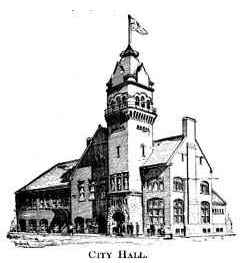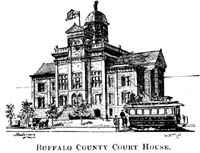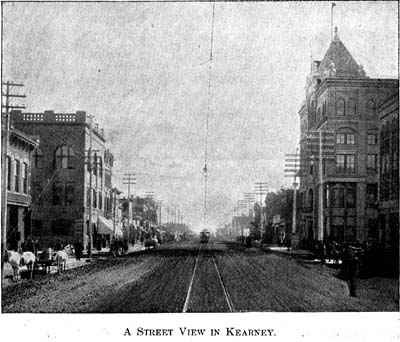NEGenWeb Project
Resource Center
On-Line Library
| 92 |
NEBRASKA'S ENTERPRISING CITIES.
|
|
Norfolk and eight in the State. He has had twelve years' experience in the express business, and is a Knight Templar and Mason. Mr. Dunn has proven one of the most faithful servants that the companies which he so ably represents at Norfolk have ever had. He is energetic, clear-headed, fair and correct in all his transactions and dealings.
"ED'S" PLACE, E. E. Lane. Proprietor.--An indispensable adjunct to a city of any size is a good restaurant where one can run in at any hour and get a lunch or a good square meal on the spur of the moment. "Ed's" Place, since its establishment, has bounded into public favor. It is open day and night. Three hands are constantly required. Oysters served in every style. Choice cigars and tobaccos. The restaurant is undoubtedly one of the best and cheapest in the State for the moderate prices charged. E. E. Lane is a native Ohioan and came here from Iowa. He formerly was a traveling salesman for five years, and previous to his present business he clerked for two years.
THE PACIFIC, Frank L. Hull, Proprietor.--This pleasantly located and attractive hotel has extended its good name throughout the State. It is heated by steam throughout and has good bath-rooms. Special attention paid to travelling men. Mr. Hull is a native of Massachusetts, and twelve years in the lintel business. He was six years manager of the Paxton at Omaha and was also in the Vendome, Boston. He is a jolly landlord and has made the Pacific a most desirable stopping place.
THE JOHNSON DRY GOODS COMPANY.--Has been founded three years. The premises are 20 x 100 feet and filled with a varied stock of imported and domestic dry goods, staple and fancy, notions. underwear and ladies' furnishing goods. They also have another house at humphrey, Neb. W. H. Johnson and O. J. Johnson are natives of Illinois, and are recognized as capable business men.
J. C. STITT, Architect; Office, 10 Mast Building.--The above skillful exponent of his profession was established here January 9, 1889, and by superior work and equitable methods has reared a prosperous business. Designs, drawings and specifications are prepared for every description of public and private buildings to he erected in any part of the country, the erection of which is superintended when desired. Mr. Stitt is a native New Yorker, and studied his profession at Syracuse, N. Y., under E. G. Hall and N. Dillenbeck.
HISTORICAL.-- Kearney's population, 1875, 250; 1885, 3,000; 1890, 8,350.  As a water station on the Union Pacific Railroad Kearney may be said to have first attracted notice. To the railroads and water Kearney owes her present importance.
As a water station on the Union Pacific Railroad Kearney may be said to have first attracted notice. To the railroads and water Kearney owes her present importance.  First came the railroad, locating its tank and saying, "Here shall be a town." The town grew with the development of agricultural interests--a few hundred each year. Then came men of brains and capital and said, "We will add to the agricultural importance of Kearney by making it a manufacturing center We will do this by creating a water power from the flow of the Platte River, which is wasting its energy through the plains." Engineers pronounced their plans feasible, and a canal was constructed, drawing its supply from the river sixteen miles west of the city, and the water thus brought to Kearney is to-day developed into thousands of horse power for manufacturing purposes. This water power through the agency of electricity furnishes light for Kearney's streets and houses, propels the street cars, operates the printing presses of the daily newspapers, and turns the wheels of many varied industries--from the dentists' drills to the flour mills with several hundred barrels per day capacity. Within two months a cotton mill of 15,000 spindles will also be operated by our water power. The undertaking is unique in the annals of town-building. Kearney
First came the railroad, locating its tank and saying, "Here shall be a town." The town grew with the development of agricultural interests--a few hundred each year. Then came men of brains and capital and said, "We will add to the agricultural importance of Kearney by making it a manufacturing center We will do this by creating a water power from the flow of the Platte River, which is wasting its energy through the plains." Engineers pronounced their plans feasible, and a canal was constructed, drawing its supply from the river sixteen miles west of the city, and the water thus brought to Kearney is to-day developed into thousands of horse power for manufacturing purposes. This water power through the agency of electricity furnishes light for Kearney's streets and houses, propels the street cars, operates the printing presses of the daily newspapers, and turns the wheels of many varied industries--from the dentists' drills to the flour mills with several hundred barrels per day capacity. Within two months a cotton mill of 15,000 spindles will also be operated by our water power. The undertaking is unique in the annals of town-building. Kearney
is the pioneer in this work, and has already reaped the benefit in having more than doubled her population since work was first begun on the canal seven years ago. The city is acknowledged as one of the foremost electrical cities of the country. Its future as a manufacturing center of the West is assured.
ELECTRICAL DEVELOPMENT.--Nearly every industry in the city uses electric power developed from Kearney's water power. A flour mill with a capacity of 200 barrels per day was one of the first mills in the country to use electric power. which it has done for nearly n year, doing away with its 125-horse power steam engine. Incandescent lights in use, 3.000: arc lights in use, 30; miles of wire strung, 68: miles of electric road operated, 5 1/2.
THE COTTON MILL.--Capacity, 26.000 yards unbleached muslin daily; employs 450 persons. Buildings: main mill, 408 x 102 feet, two stories; fan room, 92 x 27 feet, two stories; power house, 59 x 48 feet; engine room, 30 x 70 feet; tower, 33 x 27 feet, three stories, with tank for automatic sprinklers for entire building in case of fire; spindles operated, 15,000; Turbine wheel, 800-horse power, water from canal; bricks used in construction. 7,000,000: car loads of machinery for mill, 160; cost construction, $400,000.
INDUSTRIES.--Cotton mill ; flour mill and elevator; oatmeal mill; machine shops; gas works; water works; book bindery, etc.; paper mill; cracker factory; stone works; ice company; canning, pickling and vinegar

works; brick works (pressed bricks); brick works (common and paving bricks); canal and water supply company: electric company (operates light, power and street car plants); packing house; tank line; foundry and iron works; cornice works; bottling works; plow factory; cold storage, commission and seed company.
WHY MANUFACTURING WILL PAY HERE.--Because there are 14,000,000 people to-day between the Mississippi River and the Rocky Mountains, and 3,000,000 between the Rocky Mountains and the Pacific. Because there are 8,500,000 people in the States bordering Nebraska, within a circle whose radius is about 500 miles. Because Nebraska alone, with one-fifth its soil cultivated, has 1,100,000 population. Because the greatest increase in population of the nation during the present decade must be in the great Mid-West. Because the Chicago World's Fair will further the development of this section, by acquainting thousands and thousands with our resources. Because Nebraska has practically no State debtless than $500,000--and its estimated wealth in real property is $1,585,160,300. Because Kearney is midway between the two oceans--1,733 miles each way--and we are nearer many kinds of raw material than present eastern factory centers. Because our water power is reliable and cheap. Because we are demonstrating what we can do, and the present indications point to a continuance of the wonderful progress and development of Kearney and Nebraska.
|
|
|
|
|
© 2002 for the NEGenWeb Project by Pam Rietsch, Ted & Carole Miller
|
 As a water station on the Union Pacific Railroad Kearney may be said to have first attracted notice. To the railroads and water Kearney owes her present importance.
As a water station on the Union Pacific Railroad Kearney may be said to have first attracted notice. To the railroads and water Kearney owes her present importance.  First came the railroad, locating its tank and saying, "Here shall be a town." The town grew with the development of agricultural interests--a few hundred each year. Then came men of brains and capital and said, "We will add to the agricultural importance of Kearney by making it a manufacturing center We will do this by creating a water power from the flow of the Platte River, which is wasting its energy through the plains." Engineers pronounced their plans feasible, and a canal was constructed, drawing its supply from the river sixteen miles west of the city, and the water thus brought to Kearney is to-day developed into thousands of horse power for manufacturing purposes. This water power through the agency of electricity furnishes light for Kearney's streets and houses, propels the street cars, operates the printing presses of the daily newspapers, and turns the wheels of many varied industries--from the dentists' drills to the flour mills with several hundred barrels per day capacity. Within two months a cotton mill of 15,000 spindles will also be operated by our water power. The undertaking is unique in the annals of town-building. Kearney
First came the railroad, locating its tank and saying, "Here shall be a town." The town grew with the development of agricultural interests--a few hundred each year. Then came men of brains and capital and said, "We will add to the agricultural importance of Kearney by making it a manufacturing center We will do this by creating a water power from the flow of the Platte River, which is wasting its energy through the plains." Engineers pronounced their plans feasible, and a canal was constructed, drawing its supply from the river sixteen miles west of the city, and the water thus brought to Kearney is to-day developed into thousands of horse power for manufacturing purposes. This water power through the agency of electricity furnishes light for Kearney's streets and houses, propels the street cars, operates the printing presses of the daily newspapers, and turns the wheels of many varied industries--from the dentists' drills to the flour mills with several hundred barrels per day capacity. Within two months a cotton mill of 15,000 spindles will also be operated by our water power. The undertaking is unique in the annals of town-building. Kearney


